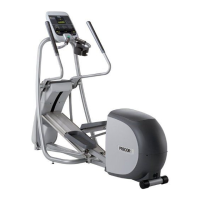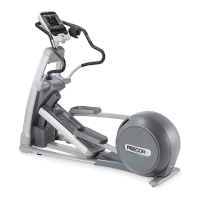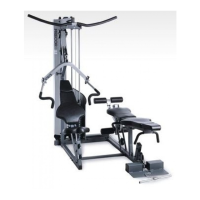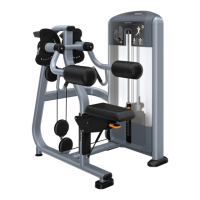General Safety and Maintenance Manual: Weekly Inspection 12
Clean and Lubricate Guide Rods
Inspect the exposed areas of the guide rods for cleanliness. Using a
dry cloth, wipe any buildup of dirt or grease from the rods.
Lubricate the exposed areas of the guide rods by applying a light coat
of a silicone spray lubricant. Spray the silicone lubricant on a rag and
then wipe the guide rods with the rag. Be careful with any lubricant
spray; it can stain carpet and clothing.
CAUTION: Do not attempt to lubricate the guide rods when the
equipment is in use. Attempting to lubricate between the weight
plates without completely disassembling the stack will result in
serious injury.
Important: Do not use petroleum-based lubricants or motor oil.
These lubricants tend to cause a rapid buildup of dirt and hair on the
weight plates, which can cause the plates to stick together.
Note: The CW802 Smith Machine has counter-balance guide rods
behind the maintenance shields, which should be cleaned and
lubricated weekly.
Inspect Cables, Connections, and
Tension
Each week give the cables and connections a thorough inspection
and check cable tensions. The following lists the specific things you
need to inspect:
• Check the cable termination at the weight stack. For most
equipment, the exposed shank can be no more than 1¼ inches
(32mm); this distance ensures a minimum of 7 turns of the bolt into
the selector stem (refer to Figure 2 earlier). Check and adjust the
distance accordingly. Also ensure that the locking jam nut is tight
against the selector stem.
• Check the cable, especially near all pulley wheels and cams.
• Check the cable as it terminates at the cam, which is stationary on
most equipment. Inspect the bolt passing through the cam end
fitting to be sure the two jam nuts are tightened against each other.
Also, check the entire cable routing to verify that there is no
interference with any structures.
• Where applicable, ensure that each cable is properly adjusted and
tightened at the top of the weight stack.
• Check cable pulleys, end connections, and end fittings. Make sure
all connections are tight, adjusting cable tension as necessary.
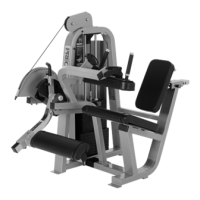
